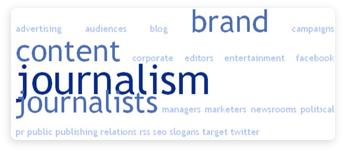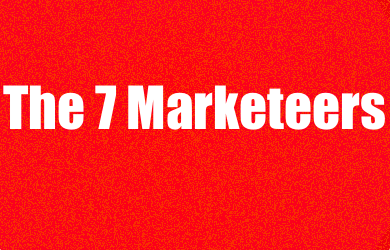 Would you like to be prepared for the unexpected? Understand the problems and desires of your customers? Have a team in place sharing valuable content that solves your customers problems? Look no further. In this article you’ll discover what “brand journalism” is, how to start and what it means in ROI for your business.
Would you like to be prepared for the unexpected? Understand the problems and desires of your customers? Have a team in place sharing valuable content that solves your customers problems? Look no further. In this article you’ll discover what “brand journalism” is, how to start and what it means in ROI for your business.
Build a Social News Organization
With brand journalism you focus on your audience. Reflect your audience interest. Know what your audience likes to hear, not what you like to tell. Start with monitoring to discover real-time, relevant, impactful conversations. Identify key people. Look at product reviews, blog posts or tweets that are relevant for your business. Identify your brand advocates or brand ambassadors. Engage with them and thank them.
To quote Kyle Monson (Content Strategy Director at JWT) : “At its most basic level, Brand Journalism involves honest brand storytelling that invites the audience to participate.”
Investigate what is happening in your market place. Start thinking as a publisher and not a marketer. Get ready to act in real-time. Create stories that focus on what is happening right now.
Leverage the Uniqueness of Each Social Media Platform
Choose the channels to engage with your audience and know how to use them. Use your blog or website as the central hub to share valuable content. This can be written news stories, videos of events, or a webinar with some recent trends in your market place.
Use Twitter to reach broad audience. Create your Facebook page to deepen the relationship with your customers, based on lighter content, with a lot of fun and humor. Focus more on the brand experience, less on the content.
Keywords are the foundation of the listening exercise. Know which keywords are relevant to discover the conversations that are relevant and have a high impact in your industry.
The challenge is to generate insights from multiple conversations via multiple channels. The conversation is diverse and fragmented. You need people who can structure the output and guide the actions your organization has to take.
Be sure everybody in your organization has a real-time mindset. They understand the importance of right now and know how to act in real time. Your teams and your company need to work together.
Hire editors and strategists with journalism and publishing backgrounds. Hire people who know how to create relevant stories with speed. People who can interact with your audience via Twitter, blog comments, Google+ or Facebook posts.
Publish Guiding Principles
Use clear guiding principles to make sure everybody in your organization can act in real time. Whatever you put in your guidelines, make sure at least these elements are included: identify yourself, share your name and company affiliation. Use “I” instead of “we”. Visit IBM Social Computing Guidelines to discover a great example of clear guidelines
Define Your Brand Journalism Goals
Define what brand journalism success looks like. Write your strategy down on paper in an easy to understand words. Make it Smart: Specific, Measurable, Action-oriented, Result oriented and Time-bound.
Some examples to guide you:
- “within 1 year we are the thought leader in our industry”. “Traditional media (like print magazines, newspapers, radio, TV refer to us every week, month, …”.
- “Our key audience regards us as the number one source to solve their problems with …”. “At the end of this year we will have 40.000 subscribers to our weekly newsletter”.
- “We are a high performing producer of trend reports, sharing the latest insights on a monthly basis”. “Each year, top 5 bloggers refer at least once to our monthly reports”.
Measure Your Brand Journalism ROI
Brand journalism is focused on long-term personal relationship building. Improve relations with your customers, employees, outside experts, traditional media, bloggers, opinion leaders and competitors. This improved relationship gives you a huge ROI.
Become a trusted news source. Generate high media attention. It will enhance your reputation. Foster positive opinions about your company. It will deepen your relationship with a much broader audience. Reducing the budget for TV commercials, radio commercials or printed ads is a huge ROI of your brand journalism strategy.
The online industry offers a lot of tools to monitor the return of your investments. These same tools enable you to engage with your key audience. Some basic tools are: search.twitter.com, google.com/insights, socialnomics.com, google.com/alerts. For more advanced monitoring tools, check out hootsuite, sproutsocial or radian6.
Create Listening reports to measure your ROI. Use quantitative and qualitative data. The quantitative data generates insights on the number of blog visitors, the number of comments, monthly growth of Twitter followers, Facebook fans, the number of subscribers to you newsletter, the mentions in traditional media, etc… The qualitative data teaches you what kind of problems people have, the language they use, what has priority, what are your competitors sharing about you, etc…
If you share great content and pay attention to search engine optimization, you will control the search engines. Instead of paying tons of money for Pay-Per-Click (PPC) advertising, you will generate loads of traffic each day via organic searches.
This organic search will increase your search engine rankings which supports your authority. That’s the ultimate ROI of your brand journalism strategy.
What are your thoughts on brand journalism? Please leave your reaction in the comment box below.









very interesting post! thanks a lot!